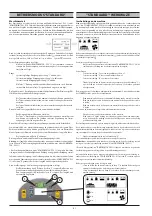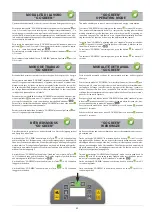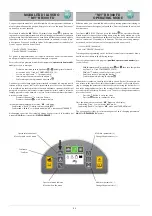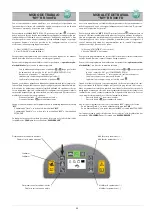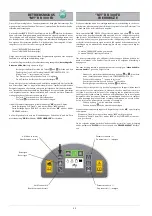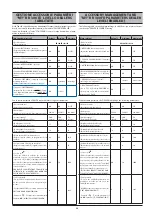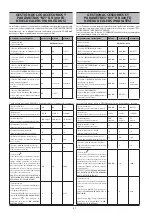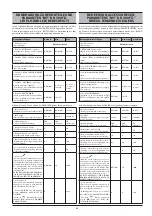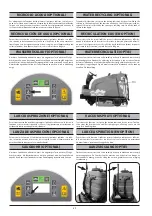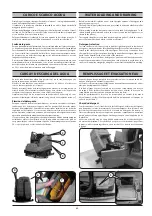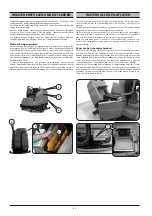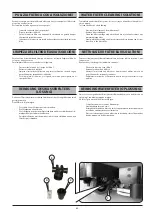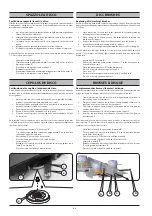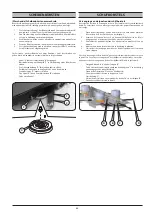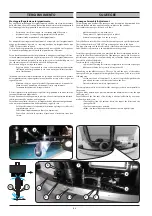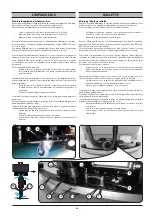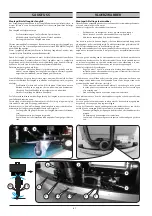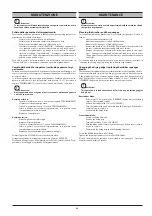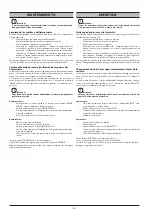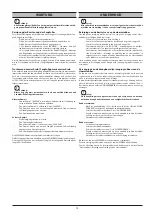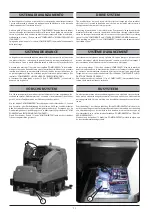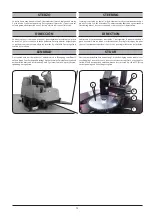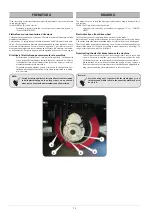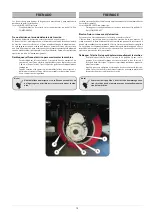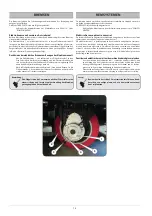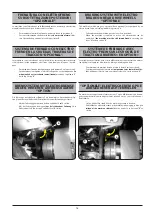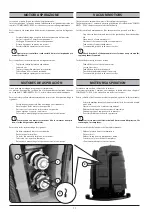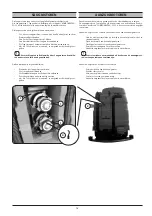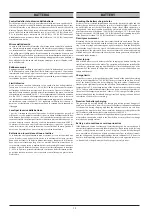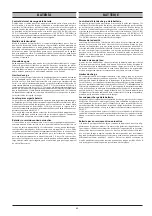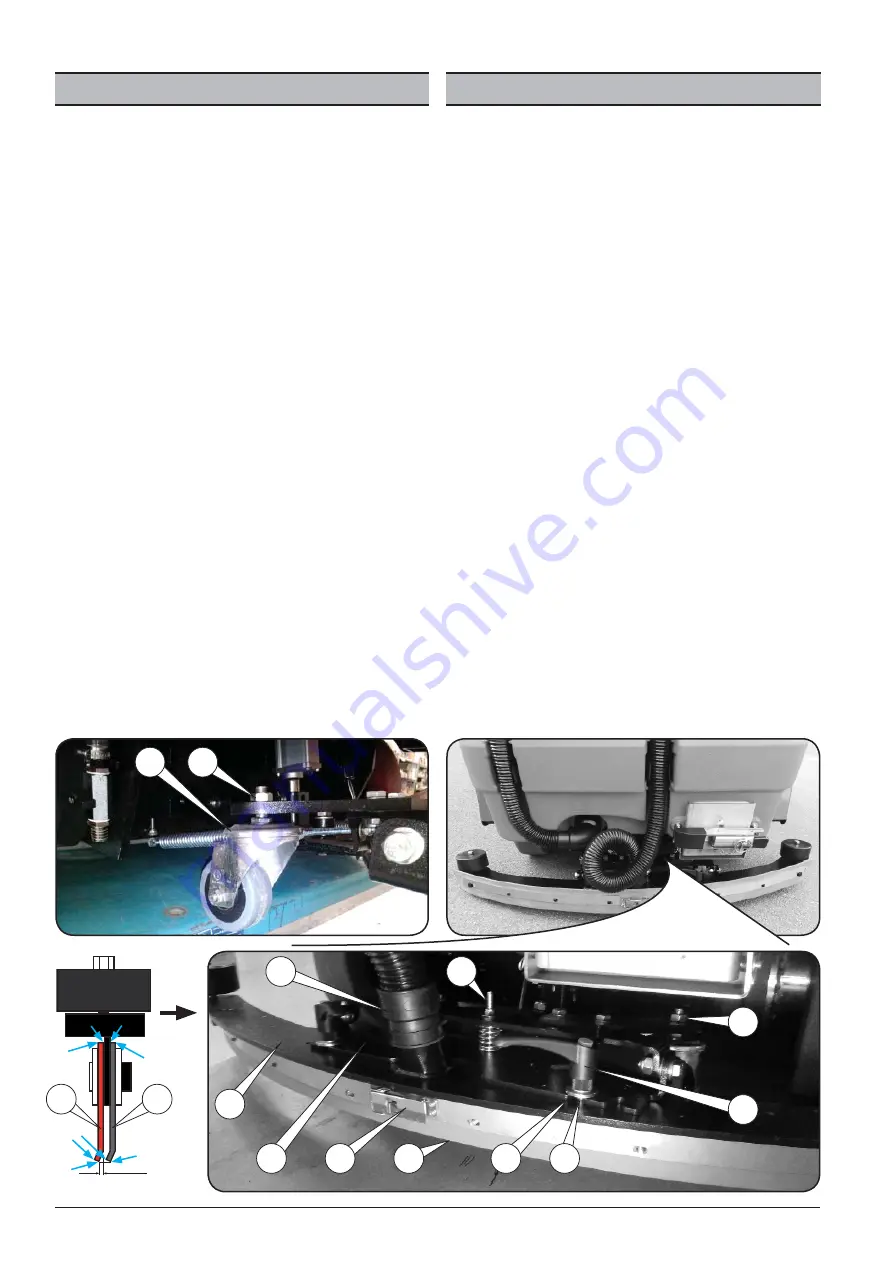
65
9
9
9
9
9
9
4,5 mm
9
9
13
8
10
11
4
5
12
10
2
1
3
8
7
6
TERGIPAVIMENTO
Montaggio/Regolazione tergipavimento
Per esigenze d’imballaggio il tergipavimento potrebbe venir fornito smontato
dalla macchina e dovrà essere applicato alla piastra di traino sulla lavapavimenti.
Per il montaggio del tergipavimento procedere nel seguente modo:
•
Posizionare i fori di centraggio 1 in corrispondenza delle asole 2.
•
Mediante le leve 3, stringere il tergipavimento 4 alla piastra 5.
•
Montare il tubo aspirazione 6 sul tergipavimento.
Per una perfetta asciugatura del pavimento é essenziale che il tergipavimento
venga perfettamente regolato. La lavasciuga utilizza un tergipavimento tipo
“CURVO”, come si vede in fi gura.
Questo tipo di tergipavimento ha la caratteristica di raccogliere bene l’acqua ver-
so il tubo di aspirazione, peró é sensibile al parallelismo col terreno.
Per un buon funzionamento del tergipavimento bisogna cercare l’angolo di lavo-
ro ideale rispetto al pavimento. La gomma posteriore 10 del tergipavimento deve
lavorare il più verticale possibile e sul suo spigolo, come si vede dalla fi gura, così
che i liquidi vengano raccolti dal lato anteriore della gomma.
Per ottenere ciò agire nel seguente modo:
•
Regolare il dado 7 ruotandolo in senso orario (avvitare) per aumentare
l’inclinazione del tergipavimento o in senso antiorario (svitare) per dimi-
nuire l’inclinazione.
In funzione dei diversi tipi di pavimento da asciugare e dall’usura delle gomme
del tergipavimento bisogna regolare la sua altezza da terra, per far ciò agire nel
seguente modo:
•
Allentare i dadi 8 e agire sui piattelli 13 per aumentare o diminuire l’al-
tezza da terra e aumentare o diminuire il carico sul pavimento.
•
Terminata la regolazione, stringere i dadi 8.
Gli stessi piattelli servono anche per regolare il tergipavimento in modo tale che
lavori parallelamente al pavimento.
Per una buona durata delle gomme, la pressione deve essere la minima indispen-
sabile, pur ottenendo una buona asciugatura.
Fare attenzione al fatto che, spesso, l’asciugatura viene infl uenzata negativamen-
te da un cattivo funzionamento dell’aspirazione, in questo caso:
•
Pulire perfettamente le tubazioni di aspirazione, gli ingressi, i fi ltri ed il
tergipavimento stesso.
•
Controllare il funzionamento del motore aspirazione.
•
Controllare che tutte le aperture d’ispezione del serbatoio siano ben
chiuse.
SQUEEGEE
Squeegee Assembly/Adjustment
For packaging requirements, the squeegee may be supplied disassembled from
the machine and must be applied to the drive plate on the scrubber.
To assemble the squeegee, proceed as follows:
•
Match centring holes 1 up with slots 2.
•
Through levers 3, tighten squeegee 4 to plate 5.
•
Assemble vacuum pipe 6 on the squeegee.
To dry the fl oor perfectly, it is essential for the squeegee to be perfectly adjusted.
The scrubber-drier uses a "CURVED" type squeegee, as seen in the fi gure.
This type of squeegee is able to effi
ciently collect the water towards the vacuum
tube. However, it is sensitive to the parallelism with the ground.
For proper squeegee operation, you must fi nd the ideal working angle with re-
spect to the fl oor. Rear rubber blade 10 of the squeegee must work as vertical as
possible and on its edge, as seen from the fi gure, so that the liquids are collected
from the front side of the blade.
To achieve this, do the following:
•
» Adjust nut 7, turning it clockwise (to tighten) to increase the squeegee
tilt or anticlockwise (to loosen) to decrease the tilt.
Depending on the diff erent types of fl oor to dry and the wear of the rubber
squeegee blade, you must adjust its height from the ground. To do so, act in the
following way:
•
Loosen nuts 8 and act on plates 13 to raise or lower the height from the
ground and increase or decrease the load on the fl oor.
•
Once adjustment is complete, tighten nuts 8.
The same plates are also used to adjust the squeegee so that it works parallel to
the ground.
For good blade duration, the pressure must be the minimum necessary, though
still drying well.
Pay attention to the fact that, often, drying is adversely aff ected by a vacuum
malfunction. In this case:
•
» Thoroughly clean the vacuum hoses, the inputs, the fi lters and the
squeegee itself.
•
» Check vacuum motor operation.
•
» Make sure that all the tank inspection hatches are tightly closed.

